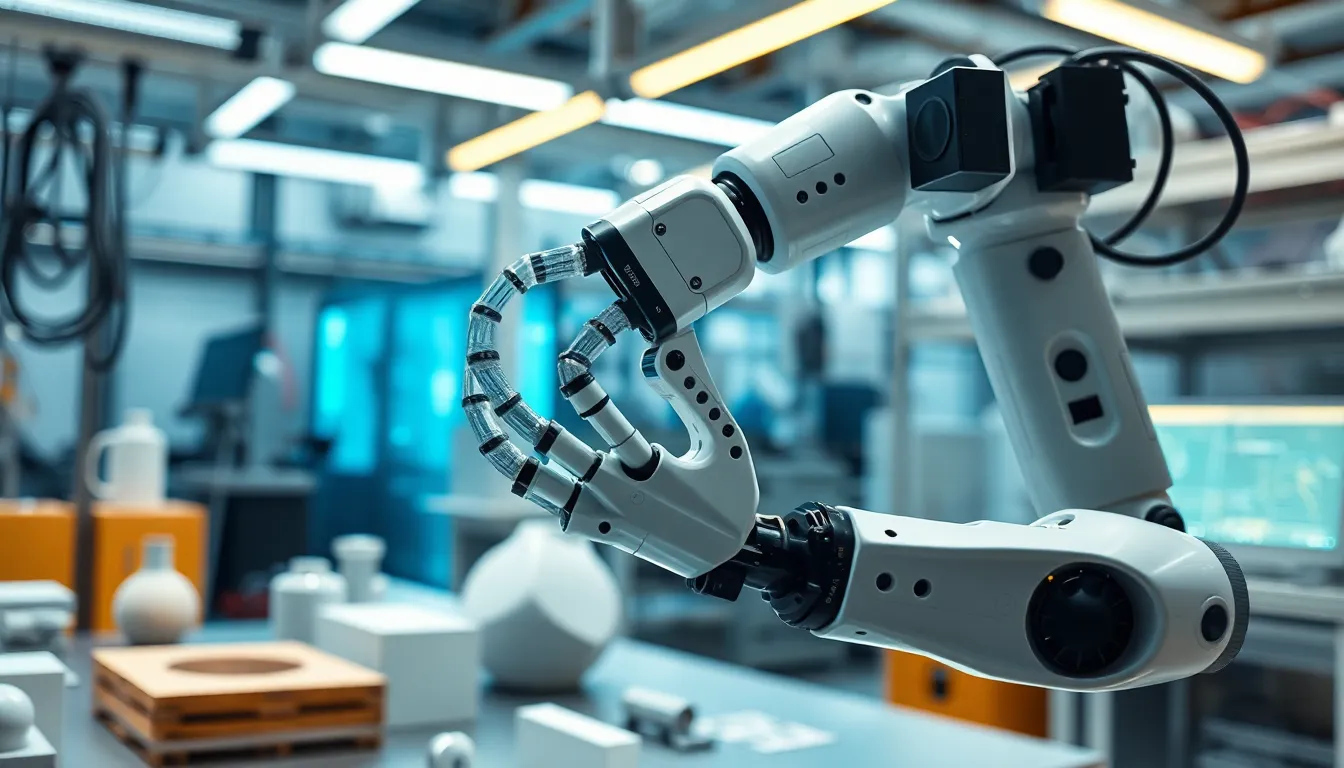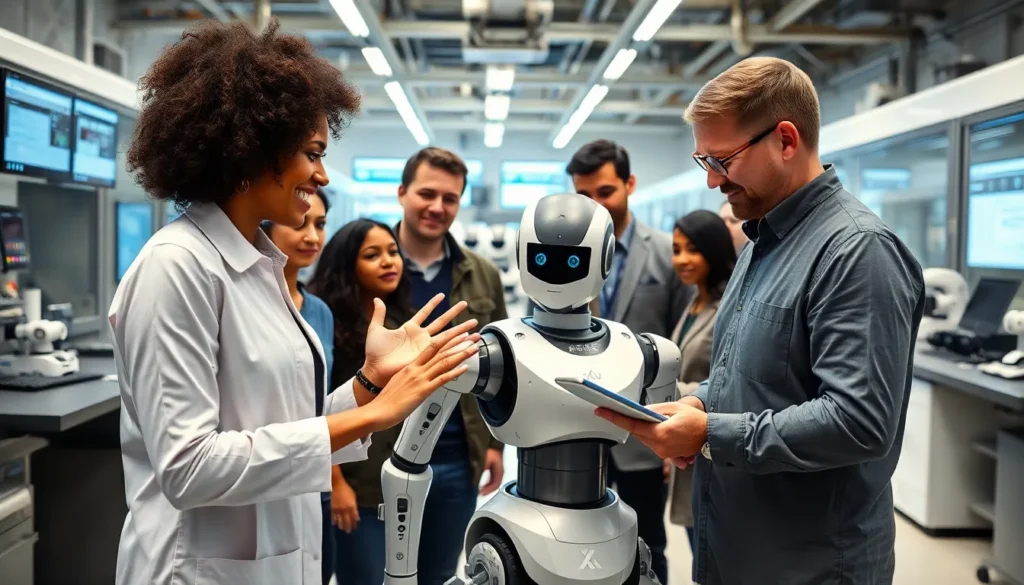Table of Contents
ToggleIn a world where robots are no longer just metal boxes with wheels, gray matter robotics is shaking things up. Imagine a future where machines not only think but also adapt, learn, and maybe even crack a joke or two. It’s not science fiction; it’s the brainy revolution happening right now in the realm of robotics.
Understanding Gray Matter Robotics
Gray matter robotics represents a significant shift in robotics, enabling machines to think, adapt, and learn. This innovation enhances current machines, making them akin to intelligent entities rather than mere mechanical devices.
Definition and Concept
Gray matter robotics refers to the integration of artificial intelligence and neural networks in robotic systems. This technology mimics the human brain’s functions, enabling robots to process information, make decisions, and learn from their experiences. It encompasses various applications, including machine learning algorithms, data processing capabilities, and cognitive computing. By leveraging these advanced systems, robots can identify patterns, adjust to new environments, and perform complex tasks autonomously, reflecting a notable leap in robotics.
Importance in Modern Technology
Gray matter robotics is crucial for modern technology, driving advancements across multiple sectors. These robots enhance efficiency in manufacturing, improve precision in healthcare applications, and enable automation in logistics. Industries benefit from decreased operational costs and increased productivity through adaptable machines. Furthermore, the use of gray matter robotics facilitates personalized customer experiences in service industries, allowing for tailored interactions. This technology fosters innovation, paving the way for smarter solutions that redefine capabilities in various fields.
Key Technologies in Gray Matter Robotics

Gray matter robotics relies on several key technologies that enable machines to simulate human-like cognitive functions. These technologies facilitate sophisticated interactions with environments and improve overall efficiency across various applications.
Artificial Intelligence Integration
Artificial intelligence (AI) forms the backbone of gray matter robotics. AI algorithms empower robots to analyze data, recognize patterns, and make informed decisions. Deep learning techniques enable machines to learn from vast datasets, improving their performance over time. Natural language processing capabilities allow robots to understand and generate human language, enhancing communication with users. Companies integrating AI, like Atlas Copco and Fanuc, exemplify the application of these technologies, pushing the boundaries of automation and collaborative robotics.
Advanced Sensors and Materials
Advanced sensors and innovative materials play a critical role in gray matter robotics. Sensors, such as LiDAR and cameras, gather real-time data about surroundings, aiding precise navigation and interaction. These sensors enhance a robot’s ability to perceive its environment and adapt accordingly. Furthermore, lightweight materials, such as carbon fiber and smart composites, contribute to improved agility and strength for robotic systems. The combination of advanced sensors and materials permits robots to operate in diverse environments, from manufacturing floors to sensitive healthcare settings, while maintaining high functionality and durability.
Applications of Gray Matter Robotics
Gray matter robotics plays a pivotal role across various sectors, offering transformative solutions to complex challenges.
Healthcare Innovations
Gray matter robotics revolutionizes healthcare by enhancing diagnostic capabilities and patient care. Intelligent robots assist in surgeries, providing precision that reduces recovery times and improves outcomes. AI-powered systems analyze medical data, leading to quicker and more accurate diagnoses. Robots equipped with natural language processing communicate effectively with patients, offering support and information, which improves patient engagement. Companies like Intuitive Surgical are pioneering these advancements with robotic surgical systems that adapt to individual patient needs, significantly impacting surgical practices.
Manufacturing and Industry
Gray matter robotics drives innovation in manufacturing, optimizing production processes and reducing downtime. Intelligent robots adapt to changing conditions on the assembly line, responding to variations in product specifications without human intervention. Automation of repetitive tasks results in enhanced efficiency and increased output. Additionally, AI algorithms monitor performance and predict maintenance needs, minimizing machine failures. Notable manufacturers such as Fanuc utilize these technologies to create smart factories, where gray matter robotics enhances productivity while ensuring quality control throughout the manufacturing process.
Challenges and Future of Gray Matter Robotics
Gray matter robotics faces several significant challenges that can impact its future development. As technology evolves, addressing these issues becomes essential for advancing the field.
Technical Limitations
Gray matter robotics encounters notable technical limitations. Processing power constraints hinder complex computations, affecting real-time decision-making and learning abilities. Memory capacity can restrict the amount of data robots process, limiting their adaptability. Additionally, sensor accuracy varies, leading to potential errors in navigation and environmental perception. These technical barriers must be overcome to enhance the capabilities of gray matter robots and enable broader applications across various sectors.
Ethical Considerations
Ethical considerations become increasingly important as gray matter robotics evolves. Concerns about job displacement arise as robots become capable of performing tasks traditionally done by humans. Privacy issues also emerge due to the data collection required for machine learning. Accountability poses another challenge; determining responsibility for robots’ actions can complicate legal and ethical frameworks. Engaging in discussions on these ethical implications ensures responsible development and deployment of gray matter robotics in society.
Gray matter robotics is reshaping the landscape of technology by introducing intelligent machines that learn and adapt. As this field continues to evolve it opens doors to unprecedented efficiencies and capabilities across various sectors. The integration of AI and advanced sensors is paving the way for smarter solutions that enhance productivity and improve user experiences.
While challenges remain in terms of technical limitations and ethical considerations addressing these issues will be crucial for the responsible advancement of this technology. Embracing gray matter robotics not only signifies a leap forward in automation but also highlights the importance of navigating its complexities to maximize benefits for society. The future of robotics is bright and full of potential as these innovations redefine what machines can achieve.




